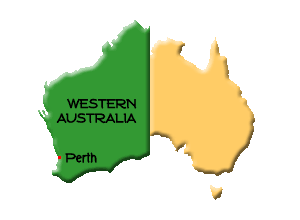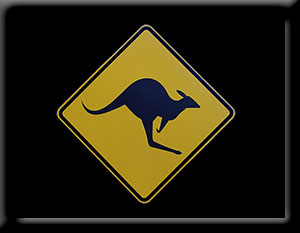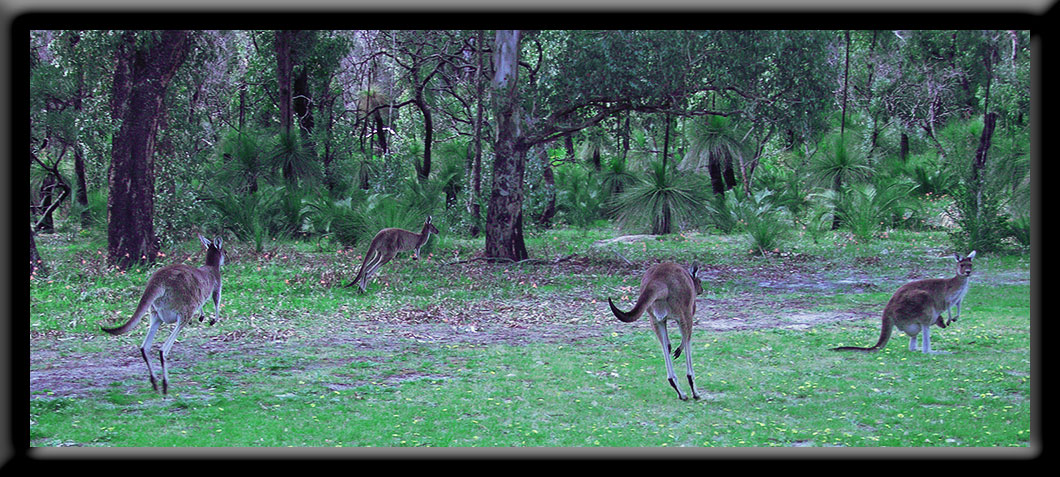G'day from W.A.

Download a free Animal Screensaver
What is a kangaroo?
Kangaroos are marsupials (pouched) belonging to the macropod (large foot) family.
The term kangaroo is used to describe the largest species from this family.
Rear feet > 250 mm and weight > 20 kg.
Generally, smaller kangaroos are called wallabies.
Four species of large kangaroo live in Western Australia:
RED KANGAROOS
Macropus rufus
live in central Australia.
Their colouring matches the red soil of the Outback giving natural camouflage from Dingoes and Eagles.

Standing taller than man, they are Australia's largest animal.
WESTERN GREY KANGAROOS
Macropus fuliginosus
can be found in the southern half of Western Australia.
These friendly, good natured herbivores are mainly nocturnal.
Male greys grow to 70 kg - females 35 kg.
EURO
Macropus robustus erubescens
These stocky, shaggy kangaroos are found all over WA except the lower south, usually in hills and ranges.
Euros have very solid shoulders and forearms, shorter hind legs and large, expressive ears.
Can be mistaken for a Red Kangaroo.
Kangaroos are one of the most abundant large wild land mammals on earth.
Current populations stand around the 50 million mark.
But, the chances are you may never see a wild kangaroo unless you drive in the country at night or visit a golf course.
Kangaroos are good swimmers and will kick each leg independently.
On land their legs can only move together.
Desert kangaroos can have three babies at the same time:
She can be pregnant for all but one day of the year - the birth day.
Hopping is extremely efficient.
At 35 km/h, a roo can outlast a chasing dog because it consumes half the oxygen.
This is due to the special geometry of the legs and the large stretchy tendons that store energy.
Also, because of this superb design, no extra energy is used when a kangaroo increases its speed.
Male kangaroos are generally known as bucks but the large specimens, and leaders of the mob, are called boomers.
Females are usually called does and the young are joeys.
In Australia, all kangaroos are protected native fauna under legislation. However, millions are harvested for overseas consumption and leather/fur products.
Decades of shooting the largest and fittest of the kangaroos has affected the natural selection process and impoverished the gene pool.
A kangaroo kept getting out of his two-metre enclosure so a five-metre fence was put up. Again he got out.
When the fence was ten metres high, a dingo in the next enclosure asked the kangaroo, "How high do you think they'll go?"
The kangaroo said, "About 100 metres, unless somebody locks the gate at night!"
Roo roo - look at you
Hopping through field and bush.
Along you go... fluidly bounding
Natural ease... so astounding.
The speed and grace
Of your amazing pace
Is truly poetry in motion.
I would love to do so too!
Handy Bushmans Trick # 72.
An easy-to-find compass if you are lost.
To cool down and escape from the hot australian sun, a kangaroo will hollow out the ground under a big shady bush on the south side.
 Kangaroos Ahead
Kangaroos AheadWarning signs are common in kangaroo country.
Night-time driving on the open road can be a nerve wracking experience,
especially after spotting your first kangaroo.
![]()
From that time on, imaginary roos are everywhere.
About 20,000 collisions between motor vehicles and kangaroos take place every year.
Kangaroos are carnivores... sometimes.
This roo was foraging in the seaweed along the beach and sniffed out a fish head.
He munched and chewed on it for about an hour and returned the next morning to finish it off, until only scraped bones remained.
